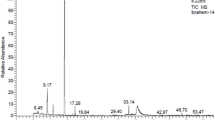Abstract
Mosquitoes in the larval stage are attractive targets for pesticides because mosquitoes breed in water, and thus, it is easy to deal with them in this habitat. The use of conventional pesticides in the water sources, however, introduces many risks to people and/or the environment. Natural pesticides, especially those derived from plants, are more promising in this aspect. Aromatic plants and their essential oils are very important sources of many compounds that are used in different respects. In this study, the oils of 41 plants were evaluated for their effects against third-instar larvae of Aedes aegypti, Anopheles stephensi and Culex quinquefasciatus. At first, the oils were surveyed against A. aegypti using a 50-ppm solution. Thirteen oils from 41 plants (camphor, thyme, amyris, lemon, cedarwood, frankincense, dill, myrtle, juniper, black pepper, verbena, helichrysum and sandalwood) induced 100% mortality after 24 h, or even after shorter periods. The best oils were tested against third-instar larvae of the three mosquito species in concentrations of 1, 10, 50, 100 and 500 ppm. The lethal concentration 50 values of these oils ranged between 1 and 101.3 ppm against A. aegypti, between 9.7 and 101.4 ppm for A. stephensi and between 1 and 50.2 ppm for C. quinquefasciatus.



Similar content being viewed by others
References
Alkofahi A, Rupprecht JK, Anderson JE, Mclaughlin JL, Mikolajczak KL, Scott BA (1989) Search for new pesticides from higher plants. In: Arnason JT, Philogene PJR, Morand P (eds) Insecticides of plant origin. American Chemical Society, Washington, DC, pp 25–43
Amer A, Mehlhorn H (2006a) Repellency effect of forty-one essential oils against Aedes, Anopheles, and Culex mosquitoes. Parasitol Res (in press)
Amer A, Mehlhorn H (2006b) The sensilla of Aedes and Anopheles mosquitoes and their importance in repellency. Parasitol Res (in press)
Ansari MA, Vasudevan P, Tandon M, Razdan RK (2000) Larvicidal and mosquito repellent action of peppermint (Mentha piperita) oil. Bioresour Technol 71:267–271
Campbell FL, Sullivan WW, Smith LN (1933) The relative toxicity of nicotine, anabasine, methyl anabasine and lupinine for culicine mosquito larvae. J Econ Entomol 26:500–509
Chokechaijaroenporn O, Bunyapraphatsara N, Kongchensin S (1994) Mosquito repellent activities of Ocimum volatile oils. Phytomedicine 1:135–139
Corbet SA, Tiley C, Moorhouse T, Giam C, Pursglove S, Raby J, Rich M (2000) Surface films as mosquito larvicides: partitioning the mode of action. Entomol Exp Appl 94:295–307
Dhillon MS, Mulla SM, Hwang YS (1982) Biocidal activity of algal toxins against immature mosquitoes. J Chem Ecol 8:557–566
Graham MA, Schooley K (1984) Toxicity of Myriophyllum and Potamogeton to mosquito larvae. Proc Pap Calif Mosq Vector Control Assoc 52:141–144
Haller HL (1940) Insecticidal properties of the fruit of Phellodendron spp. J Econ Entomol 33:941–947
Hartzell A, Wilcoxon F (1941) A survey of plant products for insecticidal properties. Contrib Boyce Thompson Inst 12:127–141
Jantan I, Ping WO, Visuvalingam SD, Ahmad NW (2003) Larvicidal activity of essential oils and methanol extracts of Malaysian plants on Aedes aegypti. Pharm Biol 41:134–136
Macedo M, Consoli RAGB, Grandi TSM, Dos Anjos AMG, de Olivira AB, Mendes NM, Queiroz RO, Zani CL (1997) Screening of Asteraceae (Compostae) plant extracts for larvicidal activity against Aedes fluviatilis (Diptera : Culicidae). Mem Inst Oswaldo Cruz 92:565–570
Minijas J, Sarda RK (1986) Laboratory observations on the toxicity of Swartzia madagascariensis (Leguminosae) extract to mosquito larvae. Trans R Soc Trop Med Hyg 80:460–461
Mohtar M, Yarmo MA, Kadri A (1999) The effects of Nerium indicum leaf extract on Aedes aegypti larvae. J Trop For Prod 5(1):87–92
Muthukrishnan J, Pushpalatha E (2001) Effects of plant extracts on fecundity and fertility of mosquitoes. J Appl Entomol 125:31–35
Muthukrishnan J, Pushpalatha E, Kasthuribai A (1997) Biological effects of four plant extracts on Culex quinquefasciatus Say larval stages. Insect Sci Appl 17:389–394
Novak D (1985) Nonchemical approaches to mosquito control in Czechoslavakia. In: Laird M, Miles JW (eds) Integrated mosquito control methodologies, vol 2. Academic, San Diego, pp 185–196
Pitasawat B, Choochote W, Kanjanapothi D, Panthong A, Jitpakdi A, Chaithong U (1998) Screening for larvicidal activity of ten carminative plants. Southeast Asian J Trop Med Public Health 29:660–662
Pushpalatha E, Muthukrishnan J (1999) Efficacy of two tropical plant extracts for the control of mosquitoes. J Appl Entomol 123:369–373
Regnault-Roger C (1997) The potential of botanical essential oils for insect pest control. Integr Pest Manag Rev 2:25–34
Rey D, David JP, Besnard G, Jullien JL, Lagnean C, Meyran JC (2001) Comparative sensitivity of larval mosquitoes to vegetable polyphenols versus conventional insecticides. Entomol Exp Appl 98:361–367
Sujatha CH, Vasuki V, Mariappan T, Kalyanasundaran M, Das PK (1988) Evaluation of plant extracts for biological activity against mosquitoes. Int Pest Control 30:122–124
WHO (1981) Instructions for determining the susceptibility or resistance of mosquito larvae to insecticides. WHO/VBC/81, 807. World Health Organization, Geneva
Wilcoxon F, Hartzell A, Wilcoxon F (1940) Insecticidal properties of extract of male fern (Aspidium filixmas (L) SW). Contrib Boyce Thompson Inst 11:1–4
Xue RD, Barnard DR, Ali A (2001) Laboratory and field evaluation of insect repellents as larvicides against the mosquitoes Aedes albopictus and Anopheles albimanus. Med Vet Entomol 15:374–380
Author information
Authors and Affiliations
Corresponding author
Rights and permissions
About this article
Cite this article
Amer, A., Mehlhorn, H. Larvicidal effects of various essential oils against Aedes, Anopheles, and Culex larvae (Diptera, Culicidae). Parasitol Res 99, 466–472 (2006). https://doi.org/10.1007/s00436-006-0182-3
Received:
Accepted:
Published:
Issue Date:
DOI: https://doi.org/10.1007/s00436-006-0182-3



